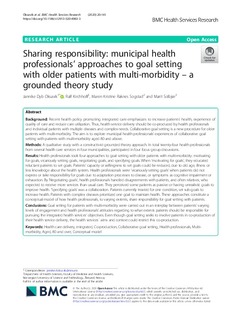| dc.contributor.author | Oksavik, Jannike Dyb | |
| dc.contributor.author | Kirchhoff, Ralf | |
| dc.contributor.author | Sogstad, Maren Kristine Raknes | |
| dc.contributor.author | Solbjør, Marit | |
| dc.date.accessioned | 2020-02-27T09:24:10Z | |
| dc.date.available | 2020-02-27T09:24:10Z | |
| dc.date.created | 2020-02-12T14:31:25Z | |
| dc.date.issued | 2020 | |
| dc.identifier.citation | BMC Health Services Research. 2020, 20 (141), . | nb_NO |
| dc.identifier.issn | 1472-6963 | |
| dc.identifier.uri | http://hdl.handle.net/11250/2644108 | |
| dc.description.abstract | Background
Recent health policy promoting integrated care emphasizes to increase patients’ health, experience of quality of care and reduce care utilization. Thus, health service delivery should be co-produced by health professionals and individual patients with multiple diseases and complex needs. Collaborative goal setting is a new procedure for older patients with multi-morbidity. The aim is to explore municipal health professionals’ experiences of collaborative goal setting with patients with multi-morbidity aged 80 and above.
Methods
A qualitative study with a constructivist grounded theory approach. In total twenty-four health professionals from several health care services in four municipalities, participated in four focus group discussions.
Results
Health professionals took four approaches to goal setting with older patients with multi-morbidity: motivating for goals, vicariously setting goals, negotiating goals, and specifying goals. When ‘motivating for goals’, they educated reluctant patients to set goals. Patients’ capacity or willingness to set goals could be reduced, due to old age, illness or less knowledge about the health system. Health professionals were ‘vicariously setting goals’ when patients did not express or take responsibility for goals due to adaptation processes to disease, or symptoms as cognitive impairment or exhaustion. By ‘Negotiating goals’, health professionals handled disagreements with patients, and often relatives, who expected to receive more services than usual care. They perceived some patients as passive or having unrealistic goals to improve health. ‘Specifying goals’ was a collaboration. Patients currently treated for one condition, set sub-goals to increase health. Patients with complex diseases prioritized one goal to maintain health. These approaches constitute a conceptual model of how health professionals, to varying extents, share responsibility for goal setting with patients.
Conclusions
Goal setting for patients with multi-morbidity were carried out in an interplay between patients’ varying levels of engagement and health professionals’ attitudes regarding to what extents patients should be responsible for pursuing the integrated health services’ objectives. Even though goal setting seeks to involve patients in co-production of their health service delivery, the health services´ aims and context could restrict this co-production. | nb_NO |
| dc.language.iso | eng | nb_NO |
| dc.publisher | BioMed Central | nb_NO |
| dc.relation.uri | https://link.springer.com/epdf/10.1186/s12913-020-4983-3?author_access_token=JrKwP705KuNQQjY0NoDoKm_BpE1tBhCbnbw3BuzI2ROeVFQulmd16faGomR68sSxsqtqEyvk3D5T3oxDdv8SIKJl9iKUclNk8S9mh1AXn2RmZoWTAGC_b8YbKUY | |
| dc.rights | Navngivelse 4.0 Internasjonal | * |
| dc.rights.uri | http://creativecommons.org/licenses/by/4.0/deed.no | * |
| dc.subject | multimorbiditet | nb_NO |
| dc.subject | multimorbidity | nb_NO |
| dc.title | Sharing responsibility: Municipal health professionals' approaches to goal setting with older patients with multi-morbidity - a grounded theory study | nb_NO |
| dc.type | Journal article | nb_NO |
| dc.type | Peer reviewed | nb_NO |
| dc.description.version | publishedVersion | nb_NO |
| dc.subject.nsi | VDP::Helsetjeneste- og helseadministrasjonsforskning: 806 | nb_NO |
| dc.subject.nsi | VDP::Health service and health administration research: 806 | nb_NO |
| dc.source.pagenumber | 11 | nb_NO |
| dc.source.volume | 20 | nb_NO |
| dc.source.journal | BMC Health Services Research | nb_NO |
| dc.source.issue | 141 | nb_NO |
| dc.identifier.doi | 10.1186/s12913-020-4983-3 | |
| dc.identifier.cristin | 1793551 | |
| dc.description.localcode | Open Access This article is distributed under the terms of the Creative Commons Attribution 4.0 International License (http://creativecommons.org/licenses/by/4.0/), which permits unrestricted use, distribution, and reproduction in any medium, provided you give appropriate credit to the original author(s) and the source, provide a link to the Creative Commons license, and indicate if changes were made. The Creative Commons Public Domain Dedication waiver (http://creativecommons.org/publicdomain/zero/1.0/) applies to the data made available in this article, unless otherwise stated. | nb_NO |
| cristin.unitcode | 194,65,80,0 | |
| cristin.unitcode | 194,65,70,20 | |
| cristin.unitcode | 194,65,20,0 | |
| cristin.unitname | Institutt for helsevitenskap Ålesund | |
| cristin.unitname | Senter for omsorgsforskning | |
| cristin.unitname | Institutt for samfunnsmedisin og sykepleie | |
| cristin.ispublished | true | |
| cristin.fulltext | original | |
| cristin.qualitycode | 2 | |

